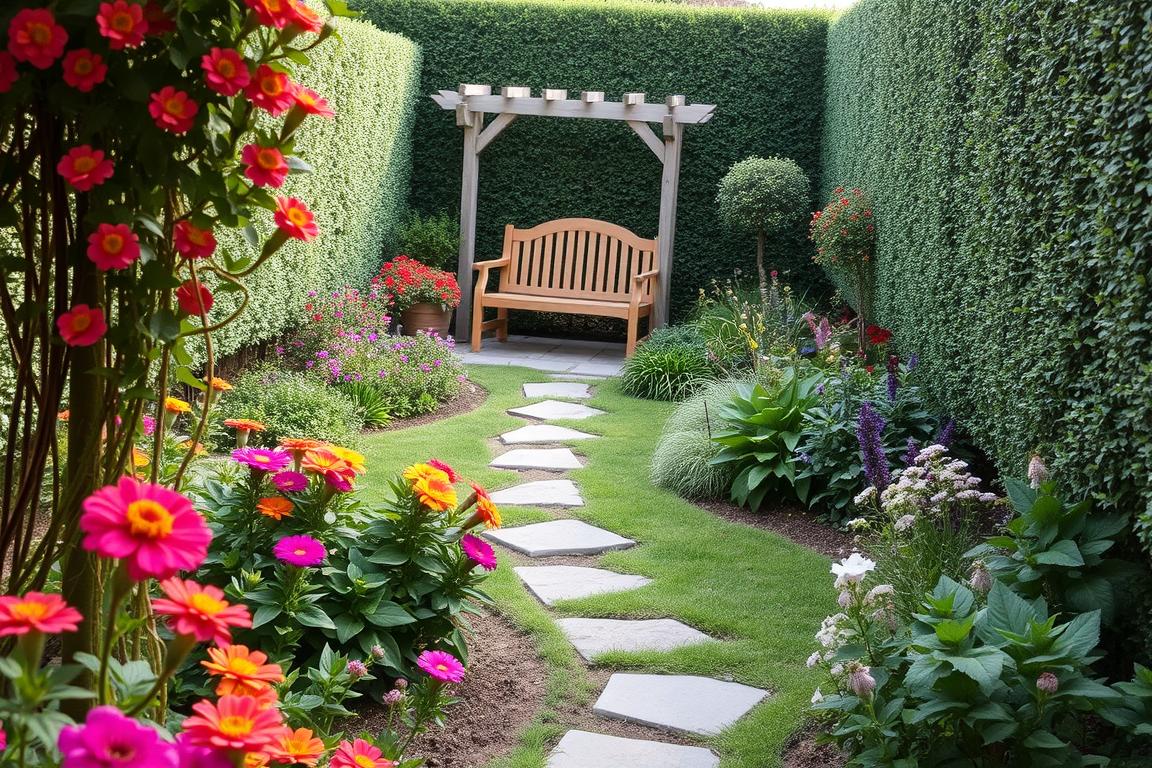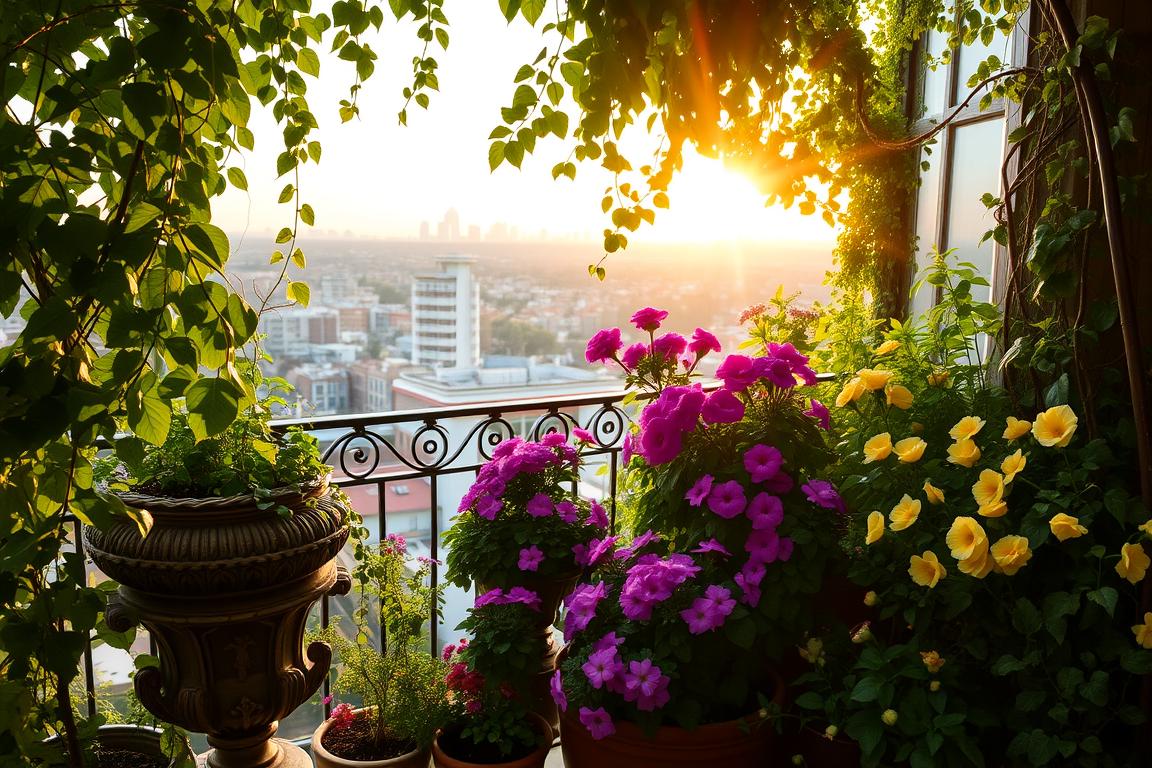Imagine stepping into a room filled with purple plants. Their calming colors create a peaceful vibe. Adding the best purple plants to your home decor can bring elegance and sophistication. They’re perfect for brightening up your living room or making your bedroom a serene retreat.
Purple plants can make your home look amazing. They add a touch of exotic beauty, bringing calm to any space. You can pick from many purple plants to find the perfect one for your home.
Table of Contents
ToggleThe Beauty of Purple Plants
Adding purple plants to your home lets you express your style. They can be a standout piece or fit seamlessly into your decor. With their vibrant colors and textures, purple plants bring life and interest to any room.
Key Takeaways
- Purple plants can add a touch of elegance and sophistication to any room
- The best purple plants for landscaping can create a sense of calm and relaxation
- Purple plants are perfect for adding a pop of color to your living room or bedroom
- Purple plants can elevate your home’s aesthetic and create a sense of serenity
- There are many varieties of purple plants to choose from, including the best purple plants for landscaping
- Purple plants can add depth and visual interest to any room
The Beauty of Purple Plants in Interior Design
Purple plants for garden can add elegance and sophistication to your home. Their rich, vibrant color brings luxury to any room. They’re perfect for creating a high-end look, whether your style is modern or traditional.
Purple plant varieties can make your home look unique and stylish. You can mix them with other colors and textures for a stunning effect. For example, pair them with beige or gray for balance, or with yellow or orange for a bold statement.
Here are some ways to use purple plant varieties in your home:
- Use them as a centerpiece for your dining or coffee table
- Place them on a shelf or mantle for a pop of color
- Create a beautiful arrangement with multiple plants and flowers
Purple plants for garden are not just beautiful; they also boost your mood and well-being. Studies show that plants can reduce stress and anxiety. With their lovely color and fragrance, purple plant varieties bring nature and tranquility into your home.
Popular Purple Plants for Indoor Spaces
Purple plants can add elegance and sophistication to your home. There are many options to choose from, fitting any style or preference. If you’re searching for purple plants for sale, try online nurseries or local gardening stores. It’s key to know how to care for purple plants to keep them healthy.
Some popular indoor plants include:
- Lavender, known for its calming scent and delicate purple flowers
- Purple Heart Plant, with its striking, deep purple leaves
- Tradescantia Zebrina, a low-maintenance plant with beautiful, purple-striped foliage

These plants are not only beautiful but also easy to care for. With a few simple tips, you can keep your purple plants thriving. Whether you’re new to gardening or experienced, learning how to care for purple plants is essential. With proper care, your purple plants for sale will enhance your home’s beauty.
Unique Purple Foliage Plants
Unique purple plants add elegance and drama to your home. They are visually striking and bring a sense of calm. Many of these plants do well in low light, making them great for indoor spaces.
Some of the most stunning unique purple plants have beautiful, detailed foliage. They add personality and create harmony in your space. They’re perfect for purifying the air or adding visual interest.
- Purple Basil, with its delicate, lacy leaves
- Coleus, with its bold, colorful foliage
These plants are not only beautiful but also easy to care for. They’re perfect for indoor spaces. Adding purple plants for shade to your home brings calm and elegance.
Purple Flowering Plants to Brighten Your Home
Purple plants with flowers are a great way to add color and beauty to your home. They are not only beautiful but also have many benefits. They attract pollinators and bring joy and happiness. With many purple plant varieties to choose from, you’ll find the perfect one for your space.
Some popular options include:
- African Violets, known for their delicate and exotic flowers
- Ornamental Allium, with its bold and striking blooms
Purple plants with flowers add elegance and sophistication to any room. They are also easy to care for, making them perfect for all gardeners. Whether you want to brighten your living room or kitchen, purple plant varieties are a great choice.

Purple plants with flowers are not just beautiful. They also attract pollinators and purify the air. With so many purple plant varieties available, you’ll find the perfect one for your needs and style.
Growing Conditions for Purple Plants
To keep your purple plants thriving, it’s essential to understand their growing conditions. Learning how to care for them will help them flourish. Whether you’re looking for purple plants for sale or already have some, knowing their needs is key.
Light is a critical factor in the growth of purple plants. Most need bright, indirect light to keep their color vibrant. Placing them near an east- or west-facing window is ideal.
Optimal Light Requirements
Some purple plants can tolerate low light, but their color may fade. To ensure they get the right light, consider these tips:
- Place them near a window with a sheer curtain to filter the light
- Avoid direct sunlight, which can cause leaves to become scorched
- Use grow lights to supplement natural light if necessary
Soil and Watering Needs
Purple plants prefer well-draining soil to prevent root rot. Water them carefully to avoid overwatering. Let the soil dry slightly between waterings. Also, avoid getting water on the leaves to prevent fungal diseases. By following these tips, you’ll create the perfect environment for your purple plants to thrive.
How to Care for Your Purple Plants
To keep your purple plants for shade healthy, give them the right care. This means fertilizing, pruning, and repotting when needed. By doing these things, you’ll enjoy your unique purple plants for many years.
Fertilizing Schedule
A balanced fertilizer is key for your purple plants. Fertilize them in spring and summer, when they grow the most.
Pruning Tips
Pruning is vital for your purple plants. It keeps them looking good, encourages new growth, and removes dead leaves. Use sharp tools to avoid spreading diseases. Prune in the dormant season to reduce stress.

By following these care tips, your purple plants will stay healthy and beautiful. Whether they’re for shade or not, they need proper care to thrive.
Best Pots and Planters for Purple Plants
Choosing the right pot for your purple plants can really enhance their beauty. A pot that matches your plant’s color and texture can add elegance to any room. For instance, a soft, neutral ceramic pot can beautifully highlight the vibrant hues of your plants.
When picking a pot, think about your plant’s size and shape. A good rule is to pick a pot that’s only 1-2 sizes bigger than your plant’s current one. This ensures the roots have room to grow without getting too wet. You can also choose from materials like glass, wood, or ceramic to add texture and interest.

- Ceramic pots in earthy tones
- Wooden planters with a natural finish
- Glass containers in a variety of shapes and sizes
By selecting a pot that complements your purple plant, you can create a stunning display. It will showcase your plant’s beauty and add sophistication to your home.
Decorating Ideas with Purple Plants
Decorating with purple plants opens up a world of possibilities. You can make a stunning centerpiece or add color to accent walls. With many purple plant varieties, you can find the perfect match for your style.
Think about the look you want in your space. Do you prefer modern or traditional? Purple plants fit any style, making them a great choice. You can mix them with other colors and textures for a unique look.
Here are some ideas to get you started:
- Use purple plants as a centerpiece for your dining or coffee table
- Add them to your accent walls for a beautiful display
- Pair them with other colors and textures for a stylish look

Adding purple plants to your decor brings elegance and sophistication. Their vibrant beauty makes them perfect for a high-end look without spending a lot. Try them out and see how they can improve your space.
Common Pests and Problems
When looking for purple plants for sale, think about pests and problems they might face. Knowing how to care for purple plants is key. Spotting issues early helps keep your plants healthy.
Common issues include root rot, leaf spot, and aphids. Ensure your plants get the right water, light, and food. Regular checks for disease or pests are also vital.

To fix common problems, first check your plant’s environment. Adjust care as needed. For example, too much water can cause root rot. By being proactive, your purple plants for sale will stay beautiful and healthy.
- Check your plants regularly for signs of disease or pests
- Adjust the care routine as needed to prevent common problems
- Provide the right amount of water, light, and nutrients for your plants
Follow these tips to keep your plants thriving. Learning how to care for purple plants is rewarding. It makes you a better plant parent and lets you enjoy purple plants for sale for years.
How to Propagate Purple Plants
Propagating purple plants is fun and rewarding. It lets you share your favorite unique purple plants or grow more for yourself. There are a few ways to do it, like division, layering, or sowing seeds. Each method has its own benefits and challenges.
To make sure your new plants grow well, give them the right conditions. This means enough light, water, and nutrients. Purple plants for shade need indirect sunlight. With proper care, your new plants will flourish and beautify any space.

- Stem cuttings: This method involves cutting a section of stem from the parent plant and rooting it in soil or water.
- Leaf cuttings: This method involves cutting a leaf from the parent plant and rooting it in soil or water.
- Seed sowing: This method involves sowing seeds from the parent plant in soil and providing the right conditions for germination.
By using these methods and giving your plants the right care, you can grow your favoriteunique purple plants. Enjoy their beauty for many years.
Creating a Purple Plant Collection
Building a purple plant collection can make your home more beautiful and joyful. By choosing a variety of purple plants, you can create a stunning display. Purple plants add elegance, creativity, and calmness, perfect for a sophisticated look.
When picking plants for your collection, mix different types for a dynamic look. African Violets have delicate flowers, while Coleus has striking leaves. Choose plants with different colors, textures, and growth habits for seasonal displays.
Purple plants are great for adding beauty to your home. They work well in centerpieces or as accent walls. They’re easy to care for and can thrive in various lighting. Start your purple plant collection to bring joy and calm to your space.
FAQ
What are the best purple plants for landscaping and gardening?
Lavender, purple heart plant, and tradescantia zebrina are top picks. They have vibrant purple leaves and flowers. They grow well in many conditions.
How do I care for purple plants?
Give your purple plants the right light, water, and food. They like well-draining soil and moderate watering. Fertilize them often to keep them colorful and healthy.
What unique purple plants can I add to my home?
Think about purple basil, coleus, African violet, and ornamental allium. They add elegance and sophistication. They come in different shapes and textures.
How do I create the best growing conditions for my purple plants?
Ensure they get the right light and have well-draining soil. Water them regularly but avoid too much. They prefer bright, indirect light and moist soil.
What are the most common pests and problems associated with purple plants?
Aphids, spider mites, and fungal diseases are common. Regularly check your plants and remove any problems. Use the right pest control and disease management.
How can I propagate my purple plants?
You can use cuttings, division, or seeds. The best method varies by plant. Generally, take cuttings, divide, or sow seeds as needed.
How can I create a stunning purple plant collection in my home?
Mix different purple plants for a stunning collection. Choose ones with varied shapes and textures. Arrange them in creative ways and change them with the seasons.














